#calligraphy tutorial
Explore tagged Tumblr posts
Text
Thoughts and observations on universal calligraphy applied on neography.
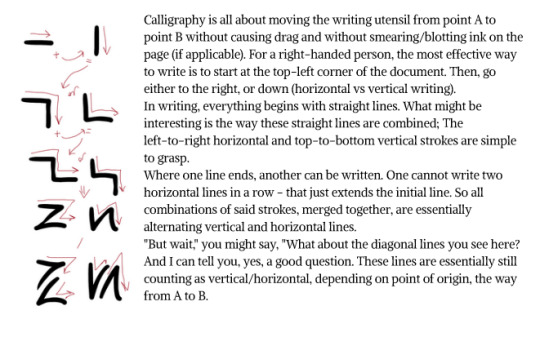

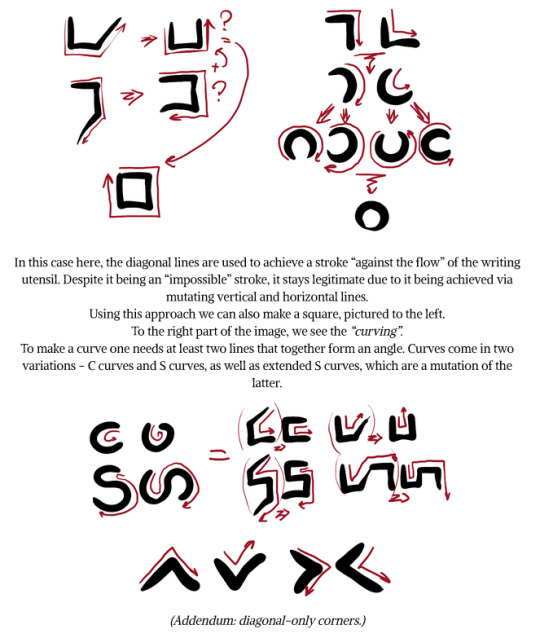


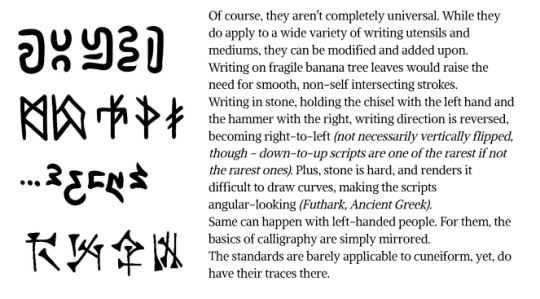
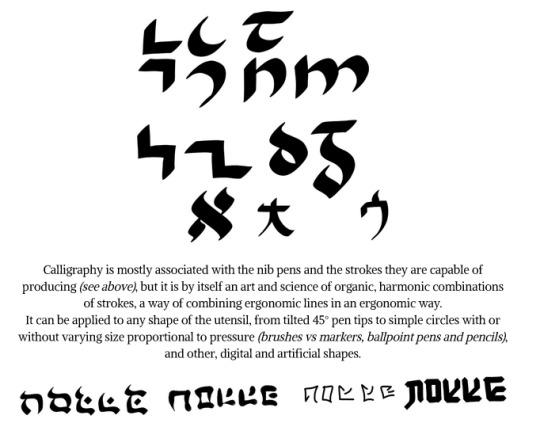

#conlangcrab#conlanging#conlang#constructed language#conlangcrab talks#linguistics#neography#calligraphy tutorial#calligraphy#conscript#art ref#art tutorial#thecrazyneographist
300 notes
·
View notes
Text
The 40th edition of the 2024 Richard Murray Newsletter
topics
The seventy-second of the Cento series. A cento is a poem made by an author from the lines of another author's work. In the series I place my cento and a link to the other authors poem.
Tutorials
May the 4th
Mona Catburger Dogfries
Dates- astrology astronomy
IF YOU MADE IT THIS FAR : France side Anime plus Manga ; Kolchak Night Stalker Night Strangler ; Eric Adams ; Blondelocs - workout queen ; KWL with Tikiri Herath ; Tolkien's Arthur ; George Carlin on Race
Edition URL https://rmnewsletter.over-blog.com/2023/11/09/29/2024-rmnewsletter-4.html
#rmnewsletter
#rmnewsletter#cento#poetryormore#labors#judasa#tutorials#dogfries#maythe4th#unknownassasin#mona#onepiece#kolchak#ericadams#blondelocs#kwl#tikiri#herath#tolkien#kingarthur#georgecarlin#race#rmaalbc#aalbc#poem#poetry#calligraphy#snowleopard#seaotter#cherryblossom#mintythedragon
2 notes
·
View notes
Text
-introductory post-
hi yall, its me
made this thing so i can post stuff im proud of on more than one account, specifically ambigrams
REQUESTS APPRECIATED AND ENCOURAGED
... if you're gonna be respectful ab it. i won't do bigoted, harmful, mean shit. the words of an ambigram are united into one beautiful work of art, and as should we. i can do most any type of ambigram, symmetrical or asymmetrical, conventional or nonconventional, or maybe one you made up! that would be really cool.
----------but flippy, what are ambigrams????------
the definition is quite hard to pinpoint, as it either is too vague to properly distinguish it from something entirely different (like synonyms, heterograms, etc) but the main thing is:
an art form where one or more words are taken and combined with respect to each other such that both are visible from different perspectives/orientations
symmetrical means it uses a single word, while asymmetrical (or symbiotic if you prefer, although that makes them sound like theyre alive) means two or more words.
----------------------flippy, i can't read them!!!!!!----------------------
yeah, it takes a really really really good ambigram to be able to be read clearly both ways. if you can't, and i mean really cant read an ambigram, it's ok, its likely nobody else does either, and i or the ambigram creator is biased to the reading bc they already know it. this is why i made this account, to try to learn how to make mine better :D
-------------but flippyy, what do they look like?????????--------------
examples include:
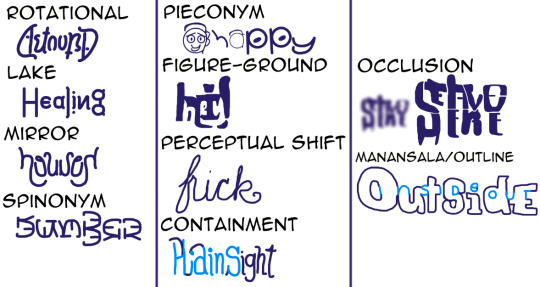
correct readings in order of top to bottom, left to right:
astound, healing, houses, dumber, 👦/happy, hi!/hey, frick/fuck, hiding/plain sight, stay/leave here, inside out/outside
#ambigram#art#digital art#calligraphy#my art#ambigrams#rotational#optical illusion#lake#mirror#spinonym#pieconym#figure ground#perceptual shift#containment#occlusion#manansala#outline#ambigram tutorial#ambigram guide
14 notes
·
View notes
Text
Unlearning and Re-learning
I have been playing around Procreate (again). I downloaded the app eons ago, but I never really gotten down and dirty with it til now 😏 because I didn’t have a pen to fully maximize its features. Of course, I could’ve just used my fingers, but who knows how that’s gonna pan out. Luckily, I found an alternative a couple of years back called Sketchbook. I have a stylus pen that came with my former…
#Aira Villegas#art#Art with Flo#calligraphy#Carlos Yulo#digital art#digital drawing#Drawing#EJ Obiena#Goodojoq#Illustration#Paris Olympics 2024#Passion Project#Philiipines#procreate#Sketchbook#tutorials
1 note
·
View note
Text

happy new year 2024
0 notes
Text
how i draw hair :) applies for TS3 & TS4
a few people have asked for this so i thought i'd just show my process, i'm still learning myself but sharing is caring. This is all done in the Procreate app on the ipad.

i used to use these brushes when i had my old ts3 acc: photoshop brushes these are super good if you might be be able to draw the individual strands, now i just use 3 brushes from samdoesart patreon:
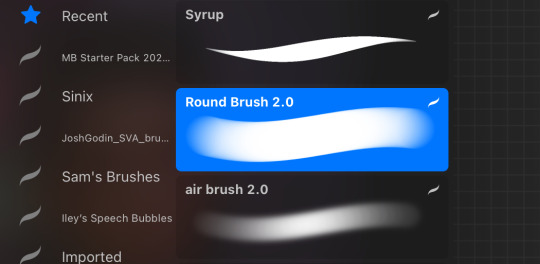
round brush: has some hard edges air brush: better for curly hair as it's soft syrup brush : i use this more for straight/wavy hair
procreate does have FREE brushes so alternatives for the brushes i use are found in: calligraphy - 'script', airbrushing - 'hard blend' & 'soft brush'.
step1: i'll gather reference on pinterest for curly/wavy hair as straight hair is more simple to draw, this help me to understand how the hair falls and where to put highlight/shadows
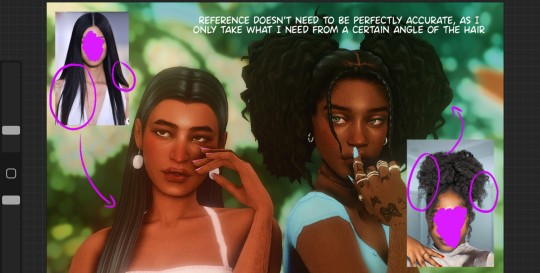
step2: *create new layer* pick the brush and colour pick the hair, i like a lot of loose strands and messy looking hair, start drawing your strands lightly and build up. The only thing that differs with sims 3 is that when drawing the strands i use a bigger brush size to start with then go in with smaller strands later.
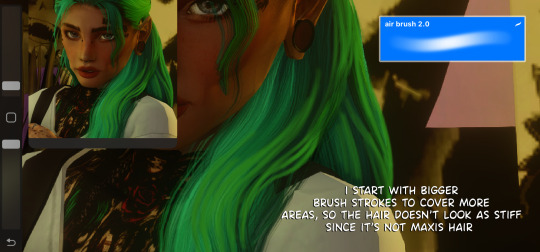
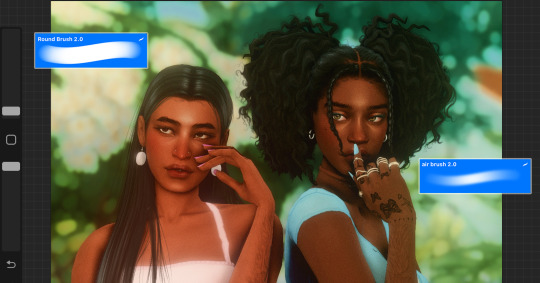
step3: *create new layer* blending mode: multiply opacity: 50-60% i'll add shadows to the parts of the hair that 'bend' to add more depth. (remember shadows are never usually completely black, so if the sim has blue hair make the shadow a dark blue)
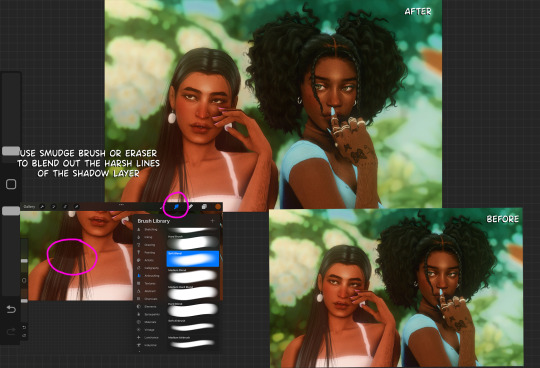
step4: *create new layer* blending mode: add. opacity 20-30%. i'll add highlight by using the selection tool and similar to how anime hair looks with the hair higlight ill add zig zag lines going around the hair, then go in with my brush lightly making the centre more intense. Once done ill get the eraser and make sure the edges aren't too harsh
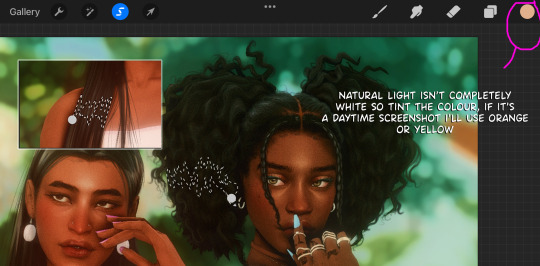
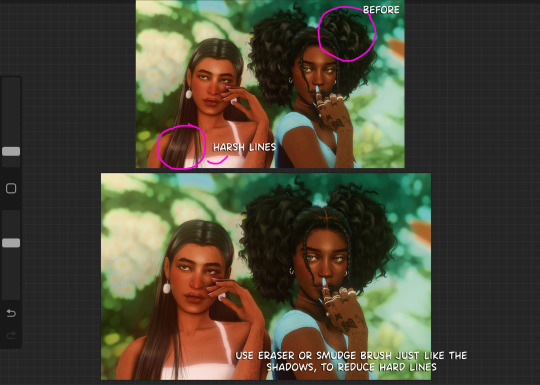
step5: *create new layer* blending mode: normal (place under shadows layer. i'll add colour highlights, (for black hair i'll use a littie bit of brown as no ones hair is really completely black)
step 6: *create new layer* blending mode: add. this one is for lighting purposes. for the rest of the screenshot then i'll add extra shine to hair & add shadows to the body
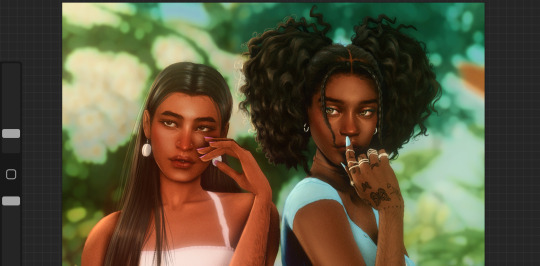
step 7: once i'm done. *create new layer* blending mode: overlay and i'll go over the parts that are in the light. merge all layers together and add some grain so the hair drawing blends in with the rest of the screenshot.
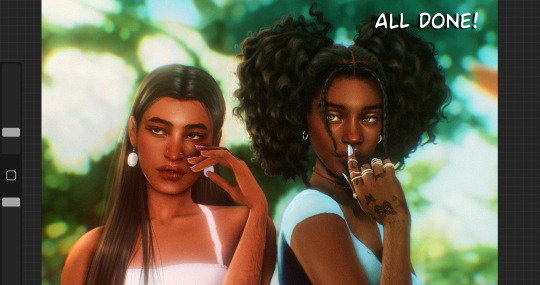
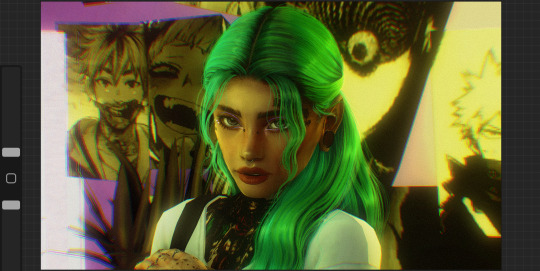
if you have any questions feel free to direct them to my inbox & u can check out other tutorials here
212 notes
·
View notes
Text
Closet Witchcraft: How To Get Witchy When You Can't Come Out Of The Broom Closet
Some basic/general tips for being a closet witch. (If you are in a severely abusive household, be sure to scroll down to the end.)
Cultivate some skills
Many skills can be put to witchy purposes if you're determined. Consider gardening, cooking, sewing, crochet, scrapbooking, painting, drawing, calligraphy, woodworking, carving, or literally any craft skill you can start practicing. If you knit a scarf with colors chosen for their magical symbolism or make a little owl sculpture as a charm to help you retain knowledge, nobody but you has to know.
Study and learn about nature
Start learning about plants, animals, geology, ecology, or whatever catches your interest. Get into the habit of observing nature wherever you are, and observing how humans and nature interact and affect each other.
Use everyday items where you can
You can practice divination with poker cards or dice, and your phone can serve as a scrying mirror. You can use a pendant or metal washer for pendulum divination.
As for cleansing, a literal wash in water is fine for any object that won't get damaged. You can use literally any cleaning tool or method with magical intent.
You can use your fingers in place of prayer beads, using either whole fingers or individual knuckles.
You can also use your fingers to trace symbols and runes on stuff.
You can represent your deities using art or knickknacks representing their symbols, like a small cat statue for Bast.
On keeping witchy literature (grimoires, Books of Shadows, printed books, etc.)
Keeping an online grimoire/BOS and getting witchy books in ebook format is often a good option.
Certain methods of practice can also reduce the amount of literature you need to keep on hand. (For example, learning correspondence through observation, using this model of deity/entity work, or practicing energy work.)
If no one is likely to go through your things, keeping your grimoire/BOS in a plain three-ring binder may be enough to avoid detection. (Camouflage is a great friend when hiding things.)
More on hiding things
So you might want something a little fancy, like a tarot deck or a more witchy-looking piece of decor.
If people aren't likely to go through your stuff or come in without knocking, you can keep a lot of things in a drawer or small storage box when you have to. Simple padlocks will be enough to keep small children and the typical casual guest out of your things.
To hide small objects, you can also get an opaque vase and fake flowers, put your witchy stuff in the bottom of the vase, and put the flowers on top.
You can also place a toilet paper tube inside a glass jar and fill it with something like small rocks, seashells, beads, buttons, or candies. (There's a tutorial for this kind of here. Though you won't need to wrap the toilet paper tube in wrapping paper, of course.)
If the jar is higher than the tube, you can glue a circle of cardboard to the bottom of the tube so you can rest it on top a layer of your filling so that it comes up to the jar's mouth.
If you want to use something like a sauce jar and want to take the label off completely, remember that oil will dissolve the adhesive.
Stuffed animals can be turned into hiding spaces. There are many tutorials out there for this.
Pieces of paper can be slipped into books. Thus you can conceal witchy reference sheets.
If you are in a seriously unhealthy situation
I wrote the above with people who don't live in severely abusive homes in mind. Like maybe the people you live with would flip out if they discovered that you're practicing witchcraft and maybe then you might be in danger, but they aren't likely to go snooping through all of your stuff and aren't going to hurt you because you breathed wrong. If you do live in a highly abusive household, I recommend checking out my post "I'm in a bad place and need to get out, what can I do?" and checking out this thread of abusive home survival tips. (These aren't witchcraft resources - they're resources to help you survive and escape.)
107 notes
·
View notes
Text
習
音読み シュウ
訓読み なら(う)
意味 learn
The kanji 習 is often associated with learning or with customs.
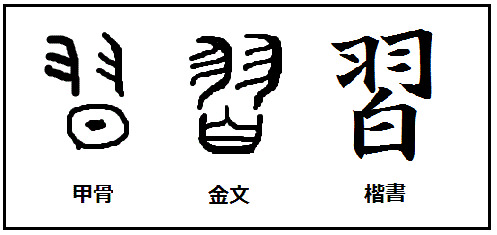
習う ならう to take lessons in; to be taught; to learn (from a teacher); to study (under a teacher); to get training in
Words ending with ~習
悪習 あくしゅう bad habit; bad custom; evil practice; vice
因習 い��しゅう convention; tired tradition; old custom (negative nuance)
演習 えんしゅう practice; exercise; drill; military exercise; seminar
慣習 かんしゅう custom; convention; common practice; becoming accustomed (to)
学習 がくしゅう study; learning; tutorial
教習 きょうしゅう training; instruction
講習 こうしゅう short course; training
実習 じっしゅう practice (in the field); training (esp. practical and hands-on); practical exercise; drill
常習 じょうしゅう custom; common practice; habit
自習 じしゅう self-study; teaching oneself; studying by oneself (at school) while the teacher is absent
独習 どくしゅう self-study; self-teaching
風習 ふうしゅう custom
復習 ふくしゅう review (of learned material); revision
補習 ほしゅう supplementary lessons
予習 よしゅう preparation for a lesson
練習 れんしゅう practice; training; drill; (an) exercise; workout
Words beginning with 習~
習慣 しゅうかん habit; (social) custom; practice; convention
習合 しゅうごう syncretism (the amalgamation of different religions, cultures, or schools of thought)
習得 しゅうとく learning; acquisition (of a skill, knowledge, etc.)
習作 しゅうさく (a) study (e.g. in music, art, sculpture, etc.); etude; practice piece
習性 しゅうせい habit; behavior; trait; nature
習字 しゅうじ penmanship; calligraphy
習熟 しゅうじゅく proficiency; mastery; becoming proficient (in)
習俗 しゅうぞく manners and customs; folkways; usage
#日本語#japanese#japanese language#japanese langblr#japanese studyblr#langblr#studyblr#語彙#単語#japanese vocabulary#漢字#kanji#tokidokitokyo#tdtstudy
63 notes
·
View notes
Text
Steps I am taking toward being more educated
While we all know education is necessary and important, I want to point out in my country, high education nowadays is one of the only ways to get a good life, aside from having a rich family (or at least it's what I was taught by my parents and seen around me till now). My family also takes great pride in being highly educated (not just academically, but any skill you can learn.) So here are the skills I'm improving, currently learning or plan on learning.
-I'm reading any books my professors or the people I look up to in my major recommend me to better understand my major and it's principals.
-One of my passions are calligraphy so I took classes for calligraphy in my language(English is not my first language) and learnt it in 3 month and now I use it in everyday life which has made me feel much better and more confident.
-I have recently started learning French and sometimes ask for help from my younger sister since she's learning it in school.
-I'm learning as much architecture software as I can so I will have a strong portfolio.
-I used to play violin, but left it 2 years ago for my university entrance exam. now I'm taking classes once again to start music all over again.
-I'm planning on learning chess, and I'll started watching tutorials or anything I can find on internet once I have time.(since I really can't afford another class, both in time and finances, since I don't want to put pressure on my father)
-I love reading book so I'm once again starting to really focus and read the books I purchased but haven't read yet)
-It's an understatement if I say I'm in love with any form of arts. I love going to galleries or museums so I read about arts and artists whenever I can so I can connect with them better.
I'm a type of person that whenever I learn a new skill or anything my confidence is boosted and I feel really good. You should do anything that makes you happy and confident. for me it's learning and in this journey of learning I'm not afraid to admit to my mistakes or ask for help, even if it's from my 11 years old sister. I yearn to learn new things from people that know something more than me. You angels, should be proud to do whatever that makes you happy and not shy away from it.💕


#it girl#self improvement#self care#that girl#studyblr#uniblr#becoming that girl#pintrest girl#pink#self growth#self love#clean girl#fit girls#tumblr girls#girlblogging#dream girl#this is a girlblog#just girly things#becoming the best version of yourself#positive thoughts#mental wellness#mental health#it girl energy#girlhood#girlblog#glow up#self help#self development
42 notes
·
View notes
Text
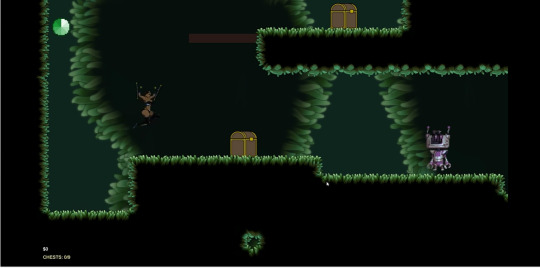
The 35th edition of the 2024 Richard Murray Newsletter.
topics
The sixty-seventh of the Cento series. A cento is a poem made by an author from the lines of another author's work. In the series I place my cento and a link to the other authors poem.
Womens History Month 2024
Human Spice Potion tutorial
The Spirit Coop
Introduction to The Sermon On The Hand and the Cordatitudes
Le Gateau Marche Avec Musique Et Entremets
Dates- astrology , astronomy , priceisright , regionalism
IF YOU MADE IT THIS FAR : Halle Berry and the evil in a thespians life , Django unchained , KWL marketing with melissa storm , Dodes'ka-den , Psycho Bliss from mystic-skillz , Skeleton Fight - from Ray HArryhausen , Tonfa Girl Game Prototype from Dualmask
URL https://rmnewsletter.over-blog.com/2023/11/09/01/2024-rmnewsletter.html
#rmnewsletter
#rmnewsletter#rmaalbc#aalbc#womenshistorymonth#tutorial#potion#human#spice#spiritcoop#kolchak#composition#ink#calligraphy#sermononthehand#cordatitudes#black#history#dos#heritage#gateau#marche#musique#entrements#dates#astrology#astronomy#priceisright#regionalism#poetryormore#xicotencatl
2 notes
·
View notes
Text
My DIY Art Degree
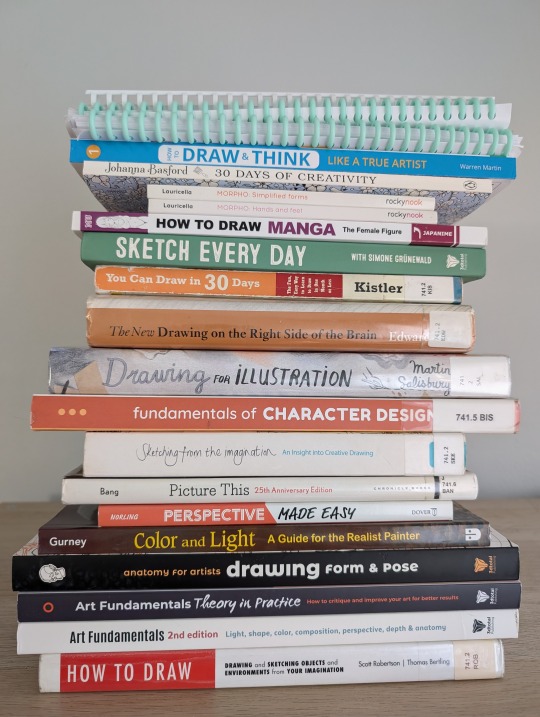
Some people think there’s an arbitrary marker where you’re finally a self-taught artist, that you eventually reach a point where you’re done with your art education. But I think we spend our whole lives learning, so my goal for my 37th year on earth is to start being a committed self-teaching artist.
I have so many interests I want to improve and learn that I can’t predict what my progress or end result will look like, but some of the things I want to explore are:
Sketching and drawing
Coloring techniques and color theory
Painting with watercolor and gouache
Painting on the Procreate app
Creative Journaling
Handwriting, hand lettering, and calligraphy
So I dug up a bunch of books and videos to make up a curriculum and planned out my own DIY art degree to start learning them all!
Each month has its own focus:
Learning About Learning Art
Mark-making, Sketching, & Basic Shapes
Perspective
Figure Drawing & Anatomy
Gesture Drawing
Character Design
Color & Light
Composition
Landscapes & Environmental Design
Using Markers & Colored Pencils
Painting with Gouache & Watercolor
Digital Art
I don’t have a syllabus for the full year planned out yet, but here’s a rough draft of the materials and activities I want to try out for Quarter 1:
❄️ January ❄️
✨January Focus: Learning About Learning Art✨
📚 January Materials 📚
Drawabox.com: Lesson 0
[Book] Art & Fear by David Bayles
[Book] Debt Free Art Degree. Foundations in Drawing by Marco Bucci: Chapters: 1
[Book] Drawing on the Right Side of the Brain by Betty Edwards
[Book] How to Keep a Sketch Journal by Marisa Lewis
[Book] Sketching from the Imagination: An Insight into Creative Drawing by 3DTotal Publishing
[Book] Art Fundamentals: Theory in Practice by 3DTotal Publishing. Chapters: Fundamentals & Critical Thinking
[YouTube] Veritasium: The 4 Things it Takes to Be an Expert
[YouTube] Ian Roberts: 5 Principles to Master Anything
[YouTube] Proko: Getting Better Faster - Painting with 80/20 Rule
[YouTube] Proko: How to Hold and Control Your Pencil
[YouTube] Sycra: Iterative Drawing
[YouTube] Love Life Drawing: 10 Stages of Learning Any Art Skill
[YouTube] Love Life Drawing: Practice Like a Pro - How Steve Rude Improves
[YouTube] Sinix: Art Theory Tutorials Playlist
[YouTube] Sinix: Art Warm Up & Exercises
[YouTube] belartsy: the “right” way to start learning how to draw
[YouTube] Paintable: Sketching For Beginners
[YouTube] Marc Brunet: How to Draw Anything - The 7 Fundamentals
[YouTube] Marc Brunet: How to Draw Good Lineart
[YouTube] Marc Brunet: Stop Learning to Draw the Wrong Way
[YouTube] Marc Brunet: The Most Important Art Skill
[LinkedIn Learning] Drawing Foundations: Fundamentals
[Gumroad] moderndayjames: Intro to Dynamic Sketching ($8)
[Reddit] r/ArtistLounge: How to get better at observing the world around me?
✍️ January Activities ✍️
Set a baseline by making whatever I want
(I know January has already passed; I'll post an update with what I actually managed to get through.)
💝 February 💝
✨ February Focus: Mark-making, Sketching, & Basic Shapes ✨
📚 February Materials 📚
[Book] How to Draw and Think Like a True Artist by Warren Martin. Days 1-5
[Book] Drawing for the Absolute Beginner by Mark and Mary Willenbrink. Chapters 1-2
[Book] You Can Draw in 30 Days by Mark Kistler. Lessons 1-7; 10-13; 15; 19
[Book] Perspective Made Easy by Ernest Norling. Chapters 1-8
[Book] Art Fundamentals 2nd Edition by 3DTotal Publishing. Chapter: Perspective & Depth
[Book] Drawing on the Right Side of the Brain by Betty Edwards
[Book] Debt Free Art Degree: Foundations in Drawing by Marco Bucci. Chapters: 1, 3
[Book] How to Draw by Scott Robertson. Chapters 1-2
[Reference Pictures] Fundamentals: Shiny Forms
[Reference Pictures] Fundamentals: Basic Forms
[YouTube] Uncomfortable: Drawabox Videos Playlist (Lesson 1)
[YouTube] moderndayjames: Perspective 1
[YouTube] moderndayjames: Perspective 2
[YouTube] moderndayjames: Perspective 6
[YouTube] The Art of Nemo: The ONLY Box Rotation Exercise That’s ACTUALLY Useful
[LinkedIn Learning] Drawing 2-Point Perspective
✍️ February Activities ✍️
drawabox.com
Lesson 1 & Homework
250 Box Challenge
🍀 March 🍀
✨March Focus: Perspective ✨
📚 March Materials 📚
[Book] Perspective Made Easy by Ernest Norling. Chapters 9-18
[Book] Drawing for the Absolute Beginner by Mark and Mary Willenbrink. Chapters 2; 5
[Book] You Can Draw in 30 Days by Mark Kistler. Lessons 22-27
[Book] How to Draw and Think like a True Artist by Warren Martin. Days 6-14
[Book] How to Draw by Scott Robertson. Chapters 2-7
[Book] Art Fundamentals 2nd Edition by 3DTotal Publishing. Chapters: Perspective & Depth
[Book] Framed Perspective I - Marco Mateu-Mestre. Chapter: 1
[Book] Debt Free Art Degree: Foundations in Drawing by Marco Bucci. Chapters: 3
[YouTube] moderndayjames: Perspective 3
[YouTube] moderndayjames: Perspective 4
[YouTube] moderndayjames: Perspective 5
[YouTube] moderndayjames: Visual Library I
[YouTube] moderndayjames: Visual Library II
[YouTube] moderndayjames: Visual Library III
[YouTube] moderndayjames: Vehicle Sketching I
[YouTube] moderndayjames: Vehicle Sketching II
[YouTube] moderndayjames: Vehicle Sketching III
[YouTube] moderndayjames: Vehicle Sketching IV
[YouTube] moderndayjames: Sketching Figures in Extreme Perspective
[YouTube] moderndayjames: Emulating Even Amundsen Series
[YouTube] moderndayjames: Becoming a Gi Series
✍️ March Activities ✍️
drawabox.com: Lesson 2 & Homework, 250 Cylinder Challenge, Begin 25 Texture Challenge
100 Rotated Objects - based on moderndayjames Visual Library videos
100 Unique Studies (machinery, vehicles, plants, animals)
🖌️ Some Ongoing Activities 🖌️
50/50 Rule: 50% studying, 50% funsies
[Book] 30 Days of Creativity by Johanna Basford
[Book] 2025 Johanna Basford Wall Calendar
[Book] The Lost Art of Handwriting by Brenna Jordan
[Book] Spencerian Handwriting: The Complete Collection of Theory and Practical Workbooks for Perfect Cursive and Hand Lettering by Platts Roger Spencer
[Workbook] New Spencerian Compendium Plate 2 Practice Sheets (Found on PDF Drive)
Hand lettering worksheets I made in Canva
This is by no means a comprehensive education, but I feel like I came up with a good introduction to the things I’m interested in. I’m not going to learn everything about all of these topics in just a year, and I know I'm not going to get through all the resources I found.
I also want to make this process as cheap as possible, so I’m using a lot of free stuff from YouTube and my local libraries. Many of the resources came from radiorunner’s Curriculum for the Solo Artist and suggestions I found through the almighty social media algorithms.
If your libraries can’t get the books on order or Inter-Library Loan, or if you’d rather just buy them to keep, I’m including Amazon affiliate links. (Many can be found as PDFs through other free methods but I definitely don’t recommend looking for the books on Demonoid, Mobilism, or PDF Drive.)
What do you think I'm missing? What do you think is too extra?
Learning is a life-long process, so even though I gave myself a year to restart, it’s just that: my restart.
24 notes
·
View notes
Text
FAQ
I made an FAQ about Commissions, online store, brushes etc here a while ago! I'll do a more informative pinned post for people who access tumblr only from their dash, so please refer to the FAQ here under the cut.
What program do you use?
I use Adobe Photoshop CC and Procreate. Photoshop for painting and colouring, Procreate for sketching and inks.
What brushes do you use?
I can’t share most brushes since I bought them ages ago and don’t have the source for them anymore, sorry. For Photoshop, I use flat or rake brushes, and one flat, calligraphy-like one that tilts with pen sensitivity, and an airbrush that has some kind of grainy paintspray effect. For Procreate, I most commonly use Max Ulichney brushes for textury brushes, standard procreate pencil brushes and Joe’s Fine Ink Line for inks.
Do you do commissions?
Not right now, no. If I do, I’ll announce it, but on Patreon first.
Do you have a patreon?
Yes, you can find it here. Support is much appreciated. 💛
Do you have an online store?
Yes, thought it’s currently closed. Will reopen hopefully in 2025, for abouth a month. Likely Q3.
What’s Heart of Gold?
Heart of Gold is a mystery/drama webcomic with overarching religious themes that revolves around the tenuous relationship which grows between the main characters Dunant and Ionel.
Is Heart of Gold on Hiatus? Will I be able to purchase volume 1 and 2 in print someday?
Yes, it’s on hiatus. We sell volume 1 at conventions, and will do our best to sell it online as well. There are some plans for volume 2 in print.
What about your Curse of Strahd campaign/CoS art?
I love to share about our campaign! I have an artbook about it, or rather, the relationship between my PC Kasper and the NPC Lydia. I’d like to make a 2nd volume of it, and maybe something more gen too in print. Feel free to ask… Hoping to do more stuff for it, as always with a big LydiaKasper & Fiona focus haha
How do you color/do you pick your colors?
Honestly, I just experiment a lot. Use the color wheel! Look at how other artists you like use colors! This helps me more than anything. This, and curves sometimes. I’ve been planning to do a tutorial for patreon for a while now, but haven’t gotten around it yet.
What pronouns do you use?
They/Them and He/Him.
#not art#this is to sum up some of the asks i’ve received regarding the aforementioned topics so apologies if i don’t reply!#one day i’d like to make a newsletter to inform yall what i’m working on next and online store stuff too but… next year… next year…….
149 notes
·
View notes
Note
in the spirit of interaction: what are your thoughts on chinese calligraphy? have you ever taken classes? (i ask because it's something of a closet hobby of mine and your header is calligraphy as well ^.^) also, what would you say the most challenging part of studying is for you?
in the spirit of interaction: thank you, and apologies it inevitably took me this long to answer!!
my actual experience with calligraphy goes hand-in-hand with my ability to handwrite: as in, not much! whenever I do end up restarting my handwriting journey (and I'm going to have another crack at it soon), however, I find the calligraphic component of it the most satisfying by far. I'm going to focus on the practical element of calligraphy as beautiful handwriting that you can actively study, rather than as an art form or studying its history.
one of the things I focused on right from the get-go with learning to handwrite chinese was to copy chinese handwriting and not typed fonts. the balance was always important: chinese is such an elegantly written language and my ugly beginner's handwriting physically hurt me. I also love handwriting in english and deliberately crafted my own cursive style when I was around 14, so I knew I wanted to pay similar attention to it in chinese. that meant I spent a lot of time 'handwriting' without knowing the characters I was writing in the beginning, purely to get a feel for the balance and shape of characters.
I think calligraphy is especially interesting to deliberately study from a practical perspective when learning to write because it provides an answer to the 'how to fit X character in a box' conundrum that always plagues me: fat characters, complex character, lopsided characters, thin and narrow characters. looking at calligraphic representations of whatever character you're trying to learn to write can show you that often this desire to fit into the box is a little misplaced: most natural chinese handwriting does have characters that are taller, broader, longer etc, and you can learn in what circumstances such a re-balance is considered beautiful and acceptable, and in what circumstances the size difference or relationship between different characters on the same line is too extreme and veers towards awkward or ugly.
I find making an effort to separate your handwriting practice (for learning the strokes) and handwriting practice (for practicing balance and style) can lead to really excellent results!! I would add a separate half an hour of practice at the end of my general handwriting daily ritual to specifically focus on one aspect of handwriting: a type of stroke, the way I held the pen or pencil (I don't regularly use brush and ink), the composition and balance of similarly composed characters.
for this, I would go to a chinese calligraphy app on my phone and search for, say, a common character like 也 that I already knew how to write. this would show me examples from different styles of calligraphy, and where the line might be between 'readable and beautiful' and 'artistic but illegible for daily life'. from there I would go on a little bit of a youtube rabbit hole watching other tutorials for that particular character - I found searching for the kanji in japanese if it's the same as the chinese character to be very helpful, as there are lots of videos for a japanese audience! - and pay attention to the key things that go wrong, its balance, where its 'centre' is and so on.
I would then go and practice writing the character, but not only that: I would try and deliberately make certain parts of it exaggerated, as much as I could, to see which parts of the writing process are 'loadbearing'. for example with 也 - the middle line often in calligraphic styles begins way above the left-most line and the hook. so from that it would become clear how the character might look sped up - I would also try and find cursive examples of each on youtube to understand which strokes are commonly joined.
all of the characters that I can write - still, after a long time away - in a way that I find pleasing or well-balanced for a non-native and unpracticed writer, are ones that I spent the time and effort into studying in this amount of detail, or ones that are analogous to other characters whose compositions I studied. the best thing about this sort of method is that, even though you might only be 'learning' one character a day, the rules and general guidelines for form, weight of the pencil, balance of composition etc are very similar across many different characters. and you learn to spend time before you write a new character examining it and figuring out where the weight of it is, what it would look like in a square, what it would look like calligraphically on its own, where it would sit on a line with other characters etc. so it all carries over to other characters you later learn, and your handwriting in general begins to improve.
in terms of calligraphy as an art form: I think part of what draws me to chinese and specifically traditional chinese culture is the emphasis on morality within craft - excellence in learning is a moral virtue. the harmony of technical excellence and virtue is something which makes me kind of go insane. and it makes sense: there is not the same separation of duty and social life and other confucian values to family, state etc with art as there is in western culture: who wrote the poems? even the poets with the most overtly daoist and/or rebellious themes had often been officials at court, even if they were hermit-ing out in the mountains or had fled their official positions. a gentleman of good standing was expected to master calligraphy, but also painting, poetry composition and so on.
with the same brush and the same paper, the three arts are inseperable: a painting is a poem and a poem is a painting, and both are enriched by the fervour or restraint or elegance or curtness or wildness of the writer or painter's brushstrokes. of course there are individual artists who are remembered more as calligraphers or painters or poets, but most 'gentlemen' and respected educated rich women (though about this I know less, being honest) would have been expected to excel at all three.
and the 'literati' was a social class, tied up of course with land and money and huge privilege, but in theory a class which anybody with the luck to receive a good education, pass the imperial exams and join the ranks of government, could enter. (of course you had to have money to be tutored in the first place since there were not schools and private tuition was the norm, but anyway...). even if you failed the exam, or failed at one of the increasingly challenging levels, your life could be transformed: you could find a job as a tutor or teacher and escape the crushing weight of a peasant's life, with room to pursue leisure.
so my appreciation for calligraphy I think ties in to my appreciation of this way of thinking and the emphasis on a well-rounded gentleman of letters, and the idea that learning and painting and writing are all forms of self-betterment and cultivation. that too ties in with the martial arts aspect of it - like you can see in films like zhang yimou's hero, where calligraphy is held up as proof of a swordsman's mastery of the sword - in a way which is kind of mocked in the west, or seen in anime with the old master at the top of the mountain, but something that does have its basis in reality. the idea that creativity itself must be based first on a solid mastery and understanding of the classics, of the works of antiquity; the idea that learning and exercising that - like you exercise your body - is a morally good thing to do. the idea that because it is moral, your own moral virtues or lack thereof, your own character, can be revealed in your calligraphy or your swordsmanship or your poetry or your art.
I don't have any especial knowledge of calligraphy itself, but the underpinning idea is very compelling to me. I suppose it's similar in some ways to the greek strenuous education of body and mind in antiquity, though I really don't know much about that. I know that the heavy and weighted respect for the classics can be stifling in a lot of education, and has worked to repress and suppress the rights of women and the lower classes. so of course there's nuance, and having taught in east asia three times I'm well aware of the frustrations and cruelties, sometimes, of a confucian-based classroom. but I still think it's something we can learn from in the west, with discernment and respect.
(I COMPLETELY FORGOT THE SECOND PART OF YOUR QUESTION!! will do another post on that, sorryyy)
#meichenxi answers#this got long and rambling sorry!!!!!#also I am writing this with no sources and acknowledge this and its likely vagueries or mistakes#please don't eat me
12 notes
·
View notes
Note
bro how are you so good at lineart and calligraphy and composition?!
I would love to see an art tutorial sometimes (only if you want to and have the time ofc)
Idk🥲 wait- DID U JUST SAY I’M GOOD IN CALLIGRAPHY?? How, I’m definitely not😭
Aaand idk if I’ll ever post the tutorial, but there’s a high possibility :P
#ask#art#huh#im not good in calligraphy#my teacher can barely even read my handwriting-#or maybe shes just blind ig#lol
11 notes
·
View notes
Text
Krita tutorial the way I know it.
Basics: What is where.
Gimmicks.
Specific advice on specific tools.
Basics: What is where.

Upon opening the program this is what you're met with. First of all, must comment: The layout is HEAVILY editable so you can just drag menus anywhere you want, even leave them floating amidst the sheet you're drawing on.
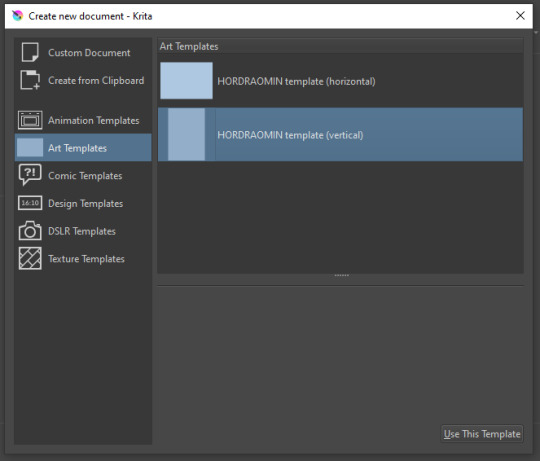
You can create custom art templates, I have two o'mine here as both have my signature background color.
As well, you can edit the custom document settings, as in what size you want it, what resolution, even the initial content of the image. As well you can create from clipboard: Just copy some image from your browser and Krita will recognize it (useful for making meme edits lol).
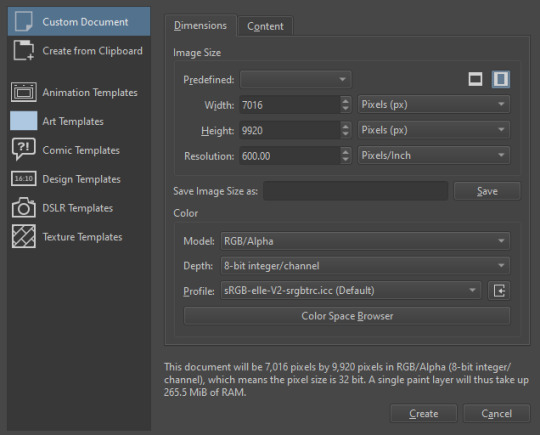

Now, once you have your file, I will show you what is where.
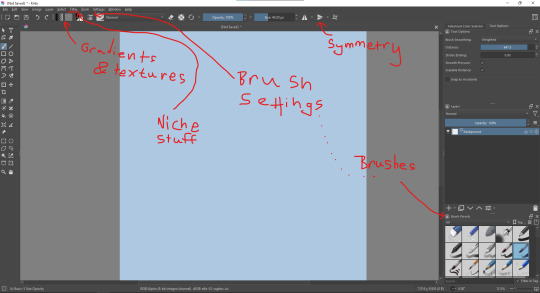
Brushes:
Brushes are easy to edit and there are tons of free bundles to download online. I myself only got one bundle, Jackpack (bit hard to find now due to original source being lost, it is still available but bit tricky to come by).
There. Are. Tons.

Some of these are my custom brushes for calligraphy in neography, you might even guess which ones. You can edit existing brushes, make new ones from the ones you've edited without changing the original, and all sorts of stuff (more below in the third chapter).
There are numerous packages of brushes once you enter Krita, but only one/two are available when you first open it. To unlock them all, click here:
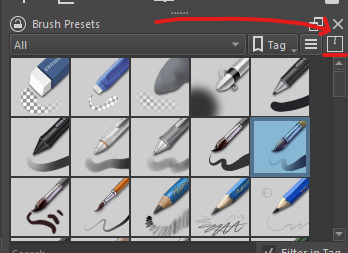
And make sure all bundles are dark gray in color (example of both dark and light below).
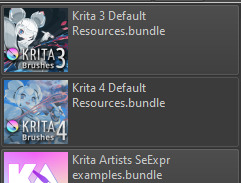
Now Tools Options: those will pop up depending on what tool you're using.
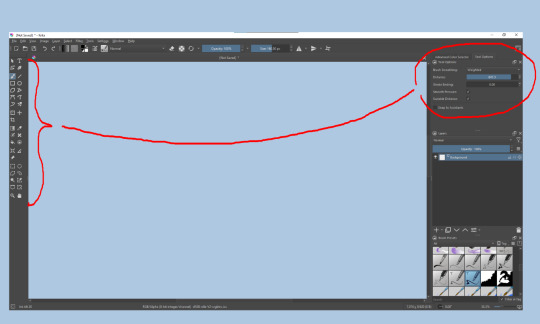
Symmetry: Fun stuff. You can drag the lines depending on how you need them and then center them back to the center of the screen if needed.
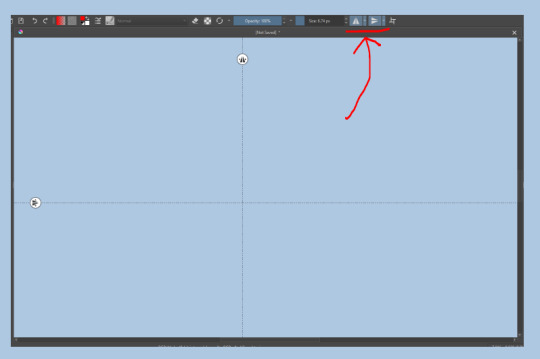
Gradients and Textures also have their tools options, you can play with those to get the feeling what they can do (more in third chapter).

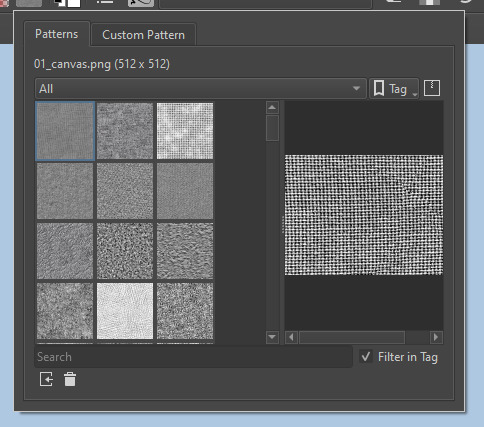
The Filters tab is useful too. Blurring, motion blurring, color mapping, artistic filters and all that: Quite fun.
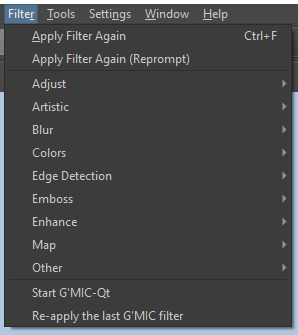
Gimmicks.
Krita allows you to customize your workspace freely. Floating menus, tabs, anything you want. It has quite many drivers at that-
To access the workspace templates, go to Window and choose Workspace.
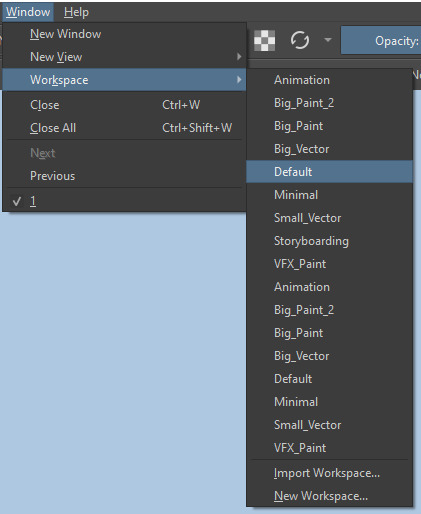
Krita allows for copy-pasting any image onto the sheet. Though, for me it sometimes crashes if I accidentally copy-paste text into it without choosing the Text tool first.
The software allows for both raster and vector work. It is basically Photoshop sharpened to be used by artists primarily.
There are some interesting mechanics regarding the Eraser (default bind E).

You can use it with any brush, allowing for textured erasure/quick work. Good for sketching.
You can use it on gradients (given there's a transparent point on the gradient preset).
There's a Multibrush tool:

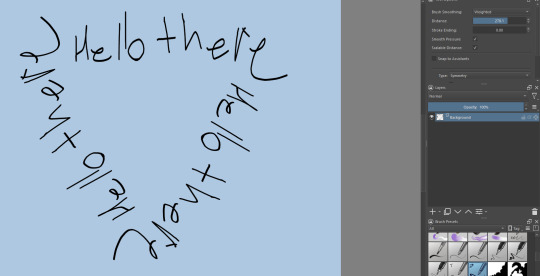
People say Krita is good for animation but my brain can't wrap around it yet honestly @~@.
The keybinds:
B - Brush tool.
E - Erase tool option.
M - Mirror (useful for checking accuracy from a new angle).
Ctrl - Color pick (when used with brush or other color-using tools).
Shift+L.Mouse+drag - Changes the size of the brush by dragging left and right.
Ctrl+E - Merge layer with the one below.
Ctrl+G - Group selected layers.
Ctrl+A - Select whole sheet.
Ctrl+Shift+A - Deselect everything.
F - Bucket tool.
G - Gradient tool.
Ctrl+S - Save document.
Ctrl+Shift+S - Save As document.
Ctrl+N - New document.
Ctrl+O - Open document (will be seen in a new tab on top of the sheet).
Ctrl+C - Copy selected layer or selection.
Ctrl+X - Cut selected layer or selection.
Ctrl+V - Paste copied/cut layer or selection.
Q - Multibrush tool.
R.Mouse - Interesting thing: Opens up a quick selector for brushes and colors you've already used in the piece.
1 - Zoom 100%.
2 - Zoom to fit the piece vertically.
3 - Zoom to fit the piece horizontally.
4, 5, 6 - Turn 15 degrees (4 and 6) or undo the turning whatsoever (5).
Ctrl+I - Negative filter applied to layer.
Ctrl+U - Color editing on the layer.
Ctrl+Y - Soft proofing mode (for color mistakes and stuff like that, mostly annoying for me tbh).
Ctrl+T - Transform selection/layer.
Ctrl+R - Square select tool.
Ctrl+J - Lasso select tool.
Honestly you can just hover your mouse over tools and see their shortcut binds, as well. Or edit them in Settings.
Specific advice on specific tools.
Brush:
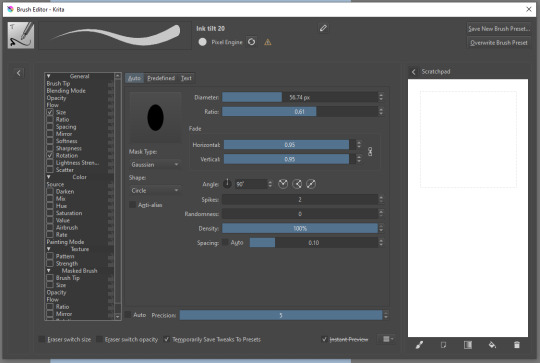
Brush editor is a great tool for making custom brushes, and it even has a sratchpad to test them out. Lots of settings, but no need to be afraid; Most of them you might never use on purpose.
Use Brush Smoothing for great and pretty lines in lining pieces or making calligraphy.
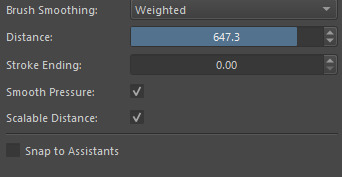
Gradient:
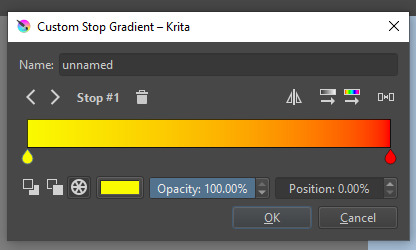
The four icons to the right top are:
Mirror gradient.
Arrange by lightness value.
Arrange by color value.
Space the stops evenly.
Click the gradient to add a new stop. The three things to the left are:
Make the stop use Primary Color.
Make the stop use Secondary Color.
Make the stop use a fixed color.
317 notes
·
View notes
Text

work in progress slugsign script for an art piece i'm planning to do that takes heavy inspiration from thuluth arabic calligraphy!! since this is mostly just going to be a "tech demo" attempt at replicating the techniques i see in those pieces, i'm just going to use the fairly straightforward tale of the tragedy of looks to the moon and five pebbles.
translation below!!
so far it translates to:
(line1)- [name] lttm [name] 5p stay (for) many-cycles [sentence end]. they question[enlightened] cycles[enlightened, religious connotation]
(line2)- they(their) many-question[enlightened] give cycle-kill[negative] [sentence end]. they give-take food-cycle-kill
(line3)- they cycle[enlightened]-predator [pause], question[enlightened] kill[enlightened] cycle [enlightened]
-
so in normal words, translated to Cool english:
(line1)- enlightened figures looks to the moon and five pebbles have been around for a long, long time. they ponder the endless cycles of reincarnation.
(line2)- their endless pondering gives the rain. they give and take the water.
(line3)- they hunt the cycles, and ponder how to end the cycles (this line is unfinished).
also, if youre curious about what the big reoccurring squares mean, here you go! a nice tutorial on the written slugsign "tone indicator ears"! (...sorry for the terrible quality on some of them)

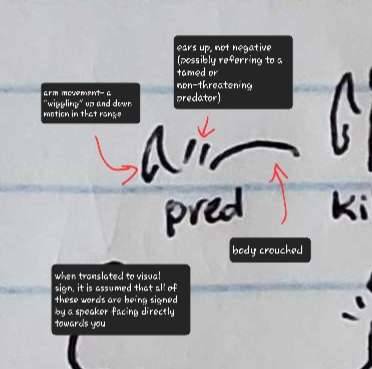

25 notes
·
View notes